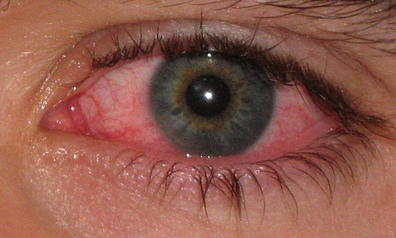Potential treatment for ‘pink eye’ epidemic
Scientists are reporting discovery of a potential new drug for epidemic keratoconjunctivitis (EKC) - sometimes called “pink eye” - a highly infectious eye disease that may occur in 15 million to 20 million people annually in the United States alone. Their report describing an innovative new “molecular wipe” that sweeps up viruses responsible for EKC appears in ACS’s Journal of Medicinal Chemistry.
Ulf Ellervik and colleagues note that there is no approved treatment for EKC, which is caused by viruses from the same family responsible for the common cold. EKC affects the cornea, the clear, dome-shaped tissue that forms the outer layer of the eye. It causes redness, pain, tearing, and may reduce visions for months. “Patients are usually recommended to stay home from work or school, resulting in substantial economic losses,” the scientists write.
They describe discovery of a potential new drug that sweeps up the viruses responsible for EKC, preventing the viruses from binding to and infecting the cornea. The drug removes viruses already in the eye and new viruses that are forming. In doing so, it would relieve symptoms, speed up healing (potentially avoiding impaired vision, and reduce and the risk of infecting the patient’s other eye or spreading the infection within families, schools and work places, the scientists suggested.
The authors acknowledge funding from Adenovir Pharma AB, The Swedish Research Council, The Crafoord Foundation, and The Royal Physiographic Society in Lund.
Conjunctivitis, commonly known as pinkeye, is an inflammation of the conjunctiva, the clear membrane that covers the white part of the eye and the inner surface of the eyelids.
While pinkeye can be alarming because it may make the eyes extremely red and can spread rapidly, it’s a fairly common condition and usually causes no long-term eye or vision damage. But if your child shows symptoms of pinkeye, it’s important to see a doctor. Some kinds of pinkeye go away on their own, but other types require treatment.
Causes
Pinkeye can be caused by many of the bacteria and viruses responsible for colds and other infections, - including ear infections, sinus infections, and sore throats - and by the same types of bacteria that cause the sexually transmitted diseases (STDs) chlamydia and gonorrhea.
Pinkeye also can be caused by allergies. These cases tend to happen more frequently among kids who also have other allergic conditions, such as hay fever. Triggers of allergic conjunctivitis include grass, ragweed pollen, animal dander, and dust mites.
Sometimes a substance in the environment can irritate the eyes and cause pinkeye; for example, chemicals (such as chlorine and soaps) and air pollutants (such as smoke and fumes).
 Types of Pink Eye
Types of Pink Eye
There are actually different types of pink/conjunctivitis eye and we will be examining each of these closely hear. It is important to know the type of conjunctivitis we are dealing with so that the correct treatment can be provided. This is why it is usually necessary to consult a physician and to have the condition properly diagnosed and treated. Here are just some of the most common causes.
Bacterial conjunctivitis is a possible reason for pink red eyes. The bacterial form of condition usually affects both eyes. In the majority of cases it will be the bacterium Staphylococcus aureus that is the culprit for the infection, but it can also be other bacterial infections such as Chlamydia.
Viral Conjunctivitis
The most frequent cause of pink eye is a viral infection. In the majority of cases this form of conjunctivitis will only affect one eye. Those people who have cold or flu like symptoms may be more likely to develop viral conjunctivitis. Special care needs to be taken if you have pink eye due to a viral cause because this is the one that is easiest to pass on to other people – in fact it can be very contagious. If there is any risk that you have viral conjunctivitis then it is advised that you see a doctor for proper treatment.
Chemically Accident Conjunctivitis
Chemically accidents are less likely to be the cause than bacteria or viruses, but it does account for a substantial number of cases of this type of eye problem. There are many chemical hazards that could cause pink eye including; sprays, household cleaners, industrial chemicals, industrial pollutants, smog, smoke, and anything that can get in the eye that doesn’t belong there. The seriousness of chemical conjunctivitis will always depend on the exact substance that has caused it in the first place.
Conjunctivitis Caused by Allergic Reaction
It is possible for conjunctivitis to occur due to an allergic reaction to something. There are many possible allergens that could bring on these symptoms including dust, pollen, and animal fur. Those who are usually susceptible to allergies are probably more likely to have pink eye due to an allergic response.
Less Common Causes
There are also less common causes of persistent pink eye such as it occurring due to another underlying condition. Rheumatoid arthritis, Lupis, Crohn’s Disease, inflammatory bowel disease (IBD), Reiter’s syndrome, vascular disease, and ulcerative colitis have all been associated with causing pink eye. Another possible reason for pink eye could be a subconjuctival haemorrhage where pressure in the eye has led to blood vessels rupturing in the area.
###
Contact: Michael Bernstein
m_bernstein@acs.org
202-872-6042
American Chemical Society